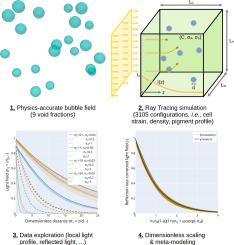Impact of bubbles on the light field within a photobioreactor: A practical design tool
IF 4.5
2区 生物学
Q1 BIOTECHNOLOGY & APPLIED MICROBIOLOGY
Algal Research-Biomass Biofuels and Bioproducts
Pub Date : 2025-10-01
DOI:10.1016/j.algal.2025.104331
引用次数: 0
Abstract
Bubbles can be strong modulators of the light field they interact with. An example of such a configuration is a photobioreactor hosting a microalgae culture where bubbles and cells contributions entangle. To investigate this question, this work computed bubble distribution in a photobioreactor setup using OpenFOAM. Then, Ray Tracing coupled with the Monte Carlo Method was used to calculate the light over 3240 configurations (cell concentrations, strains, pigment profiles, void fraction, etc.). From a physical perspective, this investigation showed that the presence of bubbles lengthens the ray path within the culture medium and increases the apparent absorption. In addition, a sizable amount of the incident light can be reflected and scattered away (about 10% for a 2.15% void fraction). From a numerical perspective, using a dimensionless approach and physics-based formulation, the whole knowledge of the database was condensed into an exponential decay (Beer–Lambert like) model. The methodology was first used on a bubble-free setup (360 profiles), where it delivered accurate local and global predictions of the light and the reflected light fraction. Then, it was expanded to the whole database. All in all, it allowed to compute the local light field, total distributed energy, and reflected light fraction with accuracies (MARE) of 9.50, 2.25, and 6.35%, respectively. It also allowed to distinguish between bubbles and microalgae contributions. Owing to its simplicity and computational efficiency, the model can be used to precisely account for detailed light distribution in large-scale models, opening the way to improving the computation of country-scale microalgae cultivation performances.

气泡对光生物反应器内光场的影响:一个实用的设计工具
气泡可以是与它们相互作用的光场的强调制器。这种配置的一个例子是承载微藻培养的光生物反应器,其中气泡和细胞的贡献缠绕在一起。为了研究这个问题,本工作使用OpenFOAM计算了光生物反应器设置中的气泡分布。然后,采用光线追踪与蒙特卡罗方法相结合的方法计算了3240种构型(细胞浓度、菌株、色素分布、空隙率等)的光场。从物理角度来看,本研究表明气泡的存在延长了培养基内的射线路径,增加了表观吸收。此外,相当数量的入射光可以被反射和散射(约10%的空隙率为2.15%)。从数值的角度来看,使用无量次方法和基于物理的公式,数据库的全部知识被浓缩成指数衰减(类似于Beer-Lambert)模型。该方法首先用于无气泡设置(360剖面),在那里它提供了准确的局部和全局光和反射光分数预测。然后,将其扩展到整个数据库。总而言之,它可以计算出局部光场、总分布能量和反射光分数,精度(MARE)分别为9.50%、2.25%和6.35%。它还可以区分气泡和微藻的贡献。该模型具有简单、计算效率高的特点,可用于精确描述大尺度模型中详细的光分布,为提高国家级微藻养殖性能的计算水平开辟了道路。
本文章由计算机程序翻译,如有差异,请以英文原文为准。
求助全文
约1分钟内获得全文
求助全文
来源期刊

Algal Research-Biomass Biofuels and Bioproducts
BIOTECHNOLOGY & APPLIED MICROBIOLOGY-
CiteScore
9.40
自引率
7.80%
发文量
332
期刊介绍:
Algal Research is an international phycology journal covering all areas of emerging technologies in algae biology, biomass production, cultivation, harvesting, extraction, bioproducts, biorefinery, engineering, and econometrics. Algae is defined to include cyanobacteria, microalgae, and protists and symbionts of interest in biotechnology. The journal publishes original research and reviews for the following scope: algal biology, including but not exclusive to: phylogeny, biodiversity, molecular traits, metabolic regulation, and genetic engineering, algal cultivation, e.g. phototrophic systems, heterotrophic systems, and mixotrophic systems, algal harvesting and extraction systems, biotechnology to convert algal biomass and components into biofuels and bioproducts, e.g., nutraceuticals, pharmaceuticals, animal feed, plastics, etc. algal products and their economic assessment
 求助内容:
求助内容: 应助结果提醒方式:
应助结果提醒方式:


